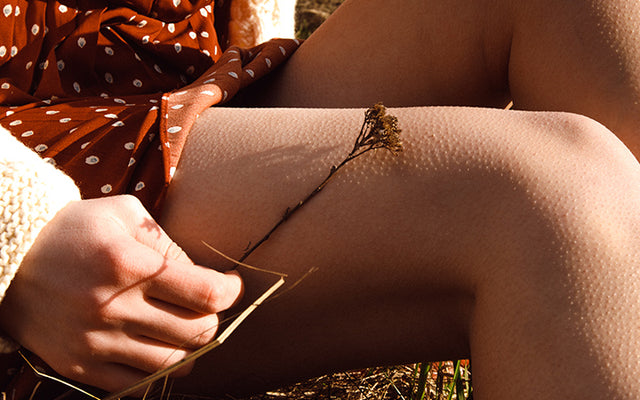You must have felt goosebumps when a cool breeze brushed past your skin or while you were watching an exciting thriller! Isn't it? But have you ever wondered what causes these small bumps on your skin? Do goosebumps have any usefulness to your skin or are they some kind of an aberration?
Read this article to know all about goosebumps on your skin and ways to prevent them.
Highlights:
What Are Goosebumps?
Goosebumps are tiny, rash like appearances on your skin that occur temporarily when you are exposed to cold or feel intense emotions such as horror, pride, excitement or sexual arousal [1]. This is also accompanied by your hair getting raised vertically above your skin.
Goosebumps are most prominent on your limbs, because that is where you usually have most of your body hair. But you can get goosebumps on other parts of your body too.
Goosebumps are so named, because when you get them, your skin looks similar to that of a goose skin from which all the feathers have been plucked. Goosebumps are also known by other names such as goose-flesh, goose-pimples or cutis anserine (cutis: skin + anserine: goose) [2].
It is interesting to note that we are not the only ones to get goosebumps, animals get them too. Ever seen a kitten that feels threatened? It will have all its fur raised, a reaction very similar to us getting goosebumps.
What Causes Goosebumps On Your Skin?
There are a number of things that can give you goosebumps. You might have just got a brilliant idea for your next project, or you just heard the song your spouse had sang on your first date! The list can be pretty long but here we jot down a few:
1. Uncomfortable Temperatures
You may get goosebumps when suddenly exposed to very low temperatures. This is the body's reflex to keep you warm. The hair standing up straight over your skin, traps a layer of air, thus forming insulation against the outside temperature.
But modern humans do not have enough body hair to provide significant insulation.[3] Thus getting goosebumps might just be a vestigial reflex- a byproduct of evolution which is no longer useful to us.
2. Strong Emotions
The phrase ‘gave me chills’ is often associated with feeling strong emotions, either positive or negative, which gives you goosebumps. Extreme joy, fear, nostalgia or intimacy can make your hair stand on their ends literally! Even the anticipation of a situation which may give rise to these feelings can cause goosebumps on your skin.
3. Drugs
Intake of certain drugs such as methamphetamine, milnacipran hydrochloride may give you goosebumps. These drugs affect the part of your nervous system that is associated with the feelings that commonly gives rise to goosebump reaction.
Withdrawal symptoms of drugs like opioids are termed as turning “cold turkey”. This is because drug withdrawal gives you goosebumps, making your skin look like the flesh of a refrigerated plucked turkey.
4. Voluntary Goosebumps
Some people have the ability to voluntarily or consciously make goosebumps appear on their body. They have this ability by birth. The exact mechanism by which this happens is still unknown.

How Do Goosebumps Develop?
The hair follicles in your skin are surrounded by the arrector pili muscles, which when contracted, pull up the hair on your body along with creating small bump-like appearances on your skin. Getting goosebumps is a reflex action which you normally cannot control. The technical terms for this reflex is pilomotor reflex, horripilation or piloerection.
When you face intense emotions or very low temperatures, the part of your nervous system called the sympathetic nervous system gets activated. This part of the nervous system is associated with our basic instinct to fight or flight when faced with a challenging situation. This results in the pilomotor reflex.
The sympathetic nervous system also increases the flow of adrenaline in your blood. This increased adrenaline causes shivering, increased heart rate, faster breathing and even tears which often accompany goosebumps. These reactions are temporary and subside by themselves once the threat has passed away.
Can Goosebumps On Skin Be Prevented?
The only way to stop getting goosebumps, is to try and avoid the circumstances that give you goosebumps in the first place. Here are a few tips to prevent getting goosebumps if you do not like them.
- Avoid chilly weather and ditch high speed AC. Wear thick clothes or use a blanket to keep yourself warm.
- Try and stay mentally calm. You can try meditation to gain control over your mind and emotions.
- Do not take illicit drugs.
- Take good care of your skin. Exfoliate and moisturize properly so that you do not get skin conditions like keratosis pilaris.
Can Goosebumps Indicate An Illness?
Goosebumps may be one of the prominent symptoms of certain diseases such as the following:
- Temporal lobe epilepsy
- Autonomic hyperreflexia commonly caused by a spinal cord injury
- Certain brain tumors
You should immediately consult your physician if you have symptoms like seizures, chills, numbness, high fever, etc. along with goosebumps.
If your skin feels like having perpetual goosebumps, you might be having a skin condition called keratosis pilaris [4]. When the dead skin cells clog the pores around the hair follicles of your skin, rough bumps like sand-grains appear on your skin. Keratosis pilaris is more common in young kids and teenagers, and usually subsides during adulthood.
Wrapping Up
Goosebumps are a primitive reflex that humans have had since a long time in the history of evolution. Even though we do not benefit much from this response anymore, it may be useful to indicate a change in weather or an intense emotion rising in our hearts. While goosebumps are usually a normal reaction, sometimes they may also accompany other medical conditions. Consult your doctor immediately if you feel concerned about getting goosebumps due a medical reason.
Recommended Products
Was this Article helpful?
- Least helpful
- Most helpful











